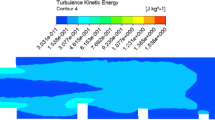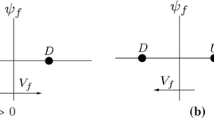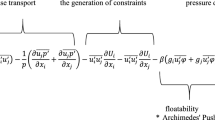Abstract
A numerical model was developed based on a moving grid method for simulating three-dimensional turbulent flows affected by curvilinear free surface. Reynolds-Averaged Navier–Stokes equations with the k–ε turbulence model were solved in non-orthogonal curvilinear coordinates. In the free surface, the kinematic boundary condition was implicitly imposed in the pressure Poisson equation derived from the momentum and continuity equations. The water surface elevation was calculated at each time step without solving additional equations. The developed numerical model was validated using the experimental data of the strongly curved channels and submerged hydraulic jump. The numerical simulation of the flow field and free surface elevation in all cases were compared with the experimental results. The agreement between the simulated and measured results was satisfactory for three-dimensional turbulent flows in the strongly curved channels and submerged hydraulic jump. The secondary flow and dip phenomena were correctly simulated in strongly curved channels. This numerical model could accurately predict steep water surface gradients in a submerged hydraulic jump. The reasonable results of the numerical simulation demonstrate the capability of the presented Lagrangian method in hydraulic engineering applications. This model provides a suitable method for simulating the free surface in engineering and environmental problems.













Similar content being viewed by others
References
Khosronejad A, Rennie CD, Salehi Neyshabouri SA, Townsend RD (2007) 3D numerical modeling of flow and sediment transport in laboratory channel bends. J Hydraul Eng 133(10):1123–1134
Zeng J, Constantinescu G, Weber L (2008) A 3D non-hydrostatic model to predict flow and sediment transport in loose-bed channel bends. J Hydraul Res 46(3):356–372
Stoesser T, Ruether N, Olsen NR (2010) Calculation of primary and secondary flow and boundary shear stresses in a meandering channel. Adv Water Resour 33(2):158–170
Van Balen W, Blanckaert K, Uijttewaal WS (2010) Analysis of the role of turbulence in curved open-channel flow at different water depths by means of experiments, LES and RANS. J Turbul 11(12):1–34
Van Balen W, Uijttewaal WS, Blanckaert K (2010) Large-eddy simulation of a curved open-channel flow over topography. Phys Fluids 22:075108
Constantinescu G, Koken M, Zeng J (2011) The structure of turbulent flow in an open channel bend of strong curvature with deformed bed: insight provided by detached eddy simulation. Water Resour Res 47:W05515
Ramamurthy AS, Han SS, Biron PM (2012) Three-dimensional simulation parameters for 90 open channel bend flows. J Comput Civ Eng 27(3):282–291
Constantinescu G, Kashyap S, Tokyay T, Rennie CD, Townsend RD (2013) Hydrodynamic processes and sediment erosion mechanisms in an open channel bend of strong curvature with deformed bathymetry. J Geophys Res: Earth Surf 118(2):480–496
Monismith SG, Fong DA (2004) A note on the potential transport of scalars and organisms by surface waves. Limnol Oceanogr 49(4):1214–1217
Long D, Steffler PM, Rajaratnam N (1991) A numerical study of submerged hydraulic jumps. J Hydraul Res 29(3):293–308
Shi J, Thomas TG, Williams JJ (1999) Development of a large-eddy simulation open channel code. Int J Numer Methods Heat Fluid Flow 9(1):6–17
Hase M, Weigand B (2004) Transient heat transfer of deforming droplets at high Reynolds numbers. Int J Numer Methods Heat Fluid Flow 14(1):85–97
Patel T, Gill L (2006) Volume of fluid model applied to curved open channel flows. Adv Fluid Mech VI 52:361–369
Feng LH, QF JI (2008) Numerical simulation for flow in channel bend using different turbulence models. J Irrig Drain 26(2):55–57
Carvalho RF, Lemos CM, Ramos CM (2008) Numerical computation of the flow in hydraulic jump stilling basins. J Hydraul Res 46(6):739–752
Shekari Y, Javan M, Eghbalzadeh A (2014) Three-dimensional numerical study of submerged hydraulic jumps. Arab J Sci Eng 39(10):6969–6981
Zhang S, Yanke JR, Johnson D, Krane JMM (2014) Modeling defects in castings using a volume of fluid method. Int J Numer Methods Heat Fluid Flow 24(2):468–482
Pan D, Chang CH (2000) The capturing of free surfaces in incompressible multi-fluid flows. Int J Numer Methods Fluids 33(2):203–222
Hodges BR, Street RL (1999) On simulation of turbulent nonlinear free-surface flows. J Comput Phys 151(2):425–457
Shibata K, Koshizuka S (2007) Numerical analysis of shipping water impact on a deck using a particle method. Ocean Eng 34(3):585–593
Shyy W, Udaykumar HS, Rao MM, Smith RW (2012) Computational fluid dynamics with moving boundaries. Courier Corporation
Ye J, McCorquodale JA (1998) Simulation of curved open channel flows by 3D hydrodynamic model. J Hydraul Eng 124(7):687–698
Wu W, Rodi W, Wenka T (2000) 3D numerical modeling of flow and sediment transport in open channels. J Hydraul Eng 126(1):4–15
Huang J, Weber LJ, Lai YG (2002) Three-dimensional numerical study of flows in open-channel junctions. J Hydraul Eng 128(3):268–280
Lin P, Li CW (2002) A σ-coordinate three-dimensional numerical model for surface wave propagation. Int J Numer Methods Fluids 38(11):1045–1068
Xiaohui S, Li CW (2002) Large eddy simulation of free surface turbulent flow in partly vegetated open channels. Int J Numer Methods Fluids 39(10):919–937
Lu WZ, Zhang WS, Cui CZ, Leung AY (2004) A numerical analysis of free-surface flow in curved open channel with velocity–pressure-free-surface correction. Comput Mech 33(3):215–224
Zhang ML, Shen YM (2008) Three-dimensional simulation of meandering river based on 3-D RNG κ–ε turbulence model. J Hydrodyn Ser. B 20(4):448–455
Zhang T, Xu WL, Chao WU (2009) Effect of discharge ratio on flow characteristics in 90° equal-width open-channel junction. J Hydrodyn Ser. B 21(4):541–549
Zhang ML, Li CW, Shen YM (2010) A 3D non-linear k–ε turbulent model for prediction of flow and mass transport in channel with vegetation. Appl Math Model 34(4):1021–1031
Zeng C, Li CW (2010) A hybrid RANS-LES model for combining flows in open-channel T-junctions. J Hydrodyn Ser. B 22(5):154–159
Li CW, Xie JF (2011) Numerical modeling of free surface flow over submerged and highly flexible vegetation. Adv Water Resour 34(4):468–477
Javan M, Namin MM, Salehi Neyshabouri SAA (2007) A time-splitting method on a nonstaggered grid in curvilinear coordinates for implicit simulation of non-hydrostatic free surface flows. Can J Civ Eng 34:99–106
Javan M, Eghbalzadeh A, Montazeri Namin M (2013) Numerical simulation of free surface in the case of plane turbulent wall jets in shallow tailwater. Civ Eng Infrastruct J 46(2):189–198
Javan M, Eghbalzadeh A (2013) 2D numerical simulation of submerged hydraulic jumps. Appl Math Model 37:6661–6669
Launder BE, Spalding DB (1974) The numerical computation of turbulent flows. Comput Methods Appl Mech Eng 3(2):269–289
Patankar SV (1980) Numerical heat transfer and fluid flow. Hemisphere, New York
Chorine AJ (1967) A numerical method for solving incompressible viscous flow problems. J Comput Phys 135(2):118–125
Kim J, Moin P (1985) Application of a fractional-step method to incompressible Navier–Stokes equations. J Comput Phys 59(2):308–323
Zang Y, Street RL, Koseff JR (1994) A non-staggered grid, fractional step method for time-dependent incompressible Navier–Stokes equations in curvilinear coordinates. J Comput Phys 114(1):18–33
Drikakis D, Iliev OP, Vassileva DP (1998) A nonlinear multigrid method for the three-dimensional incompressible Navier–Stokes equations. J Comput Phys 146(1):301–321
Savitzky A, Golay MJ (1964) Smoothing and differentiation of data by simplified least squares procedures. Anal Chem 36(8):1627–1639
Versteeg HK, Malalasekera W (1995) An introduction to computational fluid dynamics. Harlow, England
Chen HC, Patel VC (1988) Near-wall turbulence models for complex flows including separation. AIAA journal 26(6):641–648
Blanckaert K, De Vriend HJ (2004) Secondary flow in sharp open-channel bends. J Fluid Mech 498:353–380
Han SS, Ramamurthy AS, Biron PM (2011) Characteristics of flow around open channel 90 bends with vanes. J Irrig Drain Eng 137(10):668–676
Mosonyi E, Gotz W (1973) Secondary currents in subsequent model bends. Int Symp River Mech 1:191–201
Engineers UACO (1994) Engineering and design-hydraulic design of flood control channels. Engineer manual. USACE, Washington
Shukry A (1950) Flow around bends in an open flume. Trans Am Soc Civ Eng 115:751–779
Blanckaert K (2009) Saturation of curvature induced secondary flow, energy losses, and turbulence in sharp open channel bends: Laboratory experiments, analysis, and modeling. J Geophys Res: Earth Surf 114 (F3)
Nezu I, Tominaga A, Nakagawa H (1993) Field measurements of secondary currents in straight rivers. J Hydraul Eng 119(5):598–614
Humphrey JA, Pourahmadi F (1983) Prediction of curved channel flow with an extended k-epsilon model of turbulence. AIAA journal 21(10):1365–1373
Monson D, Seegmiller H, McConnaughey P (1990) Comparison of experiment with calculations using curvature-correctedzero and two equation turbulence models for a two-dimensional U-duct. In 21st Fluid Dynamics, Plasma Dynamics and Lasers Conference:1484
Rumsey CL, Gatski TB, Morrison JH (2000) Turbulence model predictions of strongly curved flow in a U-duct. AIAA journal 38(8):1394–1402
Stearns FP (1883) On the currentmeter together with a reason why the maximum velocity of flowing in open channels is below the surface. Trans of ASCE 12:331–338
Nezu I, Rodi W (1986) Open-channel flow measurements with a laser Doppler anemometer. J Hydraul Eng 112(5):335–355
Author information
Authors and Affiliations
Corresponding author
Rights and permissions
About this article
Cite this article
Javan, M., Mahmodinia, S. & Hasani, H. Development and validation of a Lagrangian method for 3D turbulent flows with curvilinear free-surface. Environ Fluid Mech 17, 1153–1170 (2017). https://doi.org/10.1007/s10652-017-9541-0
Received:
Accepted:
Published:
Issue Date:
DOI: https://doi.org/10.1007/s10652-017-9541-0




